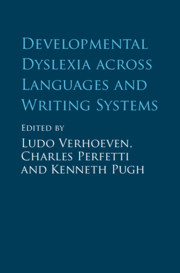Book contents
- Developmental Dyslexia across Languages and Writing Systems
- Developmental Dyslexia across Languages and Writing Systems
- Copyright page
- Contents
- Figures
- Tables
- Contributors
- 1 Introduction
- Part I Developmental Dyslexia across Languages and Writing Systems
- 2 Developmental Dyslexia in English
- 3 Developmental Dyslexia in French
- 4 Developmental Dyslexia in Dutch
- 5 Developmental Dyslexia in Czech and Slovak
- 6 Developmental Dyslexia in Finnish
- 7 Developmental Dyslexia in Russian
- 8 Developmental Dyslexia in Hebrew
- 9 Developmental Dyslexia in Japanese
- 10 Developmental Dyslexia in Chinese
- Part II Cross-Linguistic Perspectives on Developmental Dyslexia
- Epilogue
- Index
- References
6 - Developmental Dyslexia in Finnish
from Part I - Developmental Dyslexia across Languages and Writing Systems
Published online by Cambridge University Press: 27 September 2019
- Developmental Dyslexia across Languages and Writing Systems
- Developmental Dyslexia across Languages and Writing Systems
- Copyright page
- Contents
- Figures
- Tables
- Contributors
- 1 Introduction
- Part I Developmental Dyslexia across Languages and Writing Systems
- 2 Developmental Dyslexia in English
- 3 Developmental Dyslexia in French
- 4 Developmental Dyslexia in Dutch
- 5 Developmental Dyslexia in Czech and Slovak
- 6 Developmental Dyslexia in Finnish
- 7 Developmental Dyslexia in Russian
- 8 Developmental Dyslexia in Hebrew
- 9 Developmental Dyslexia in Japanese
- 10 Developmental Dyslexia in Chinese
- Part II Cross-Linguistic Perspectives on Developmental Dyslexia
- Epilogue
- Index
- References
Summary
Written Finnish and the Finnish literacy culture provide an exceptional context for an interesting separation of the various processes associated with reading acquisition. The orthography of Finnish is relatively optimally wired to give young learners an easy time acquiring basic decoding skills. Finnish orthography has full transparency in both reading and writing. After learning the limited set of sounds connected consistently with specific graphemes, learners usually learn to decode accurately, even those with learning difficulties in reading.
The high status of literacy in Finland, which dates from the early stages of its writing system, has led to additional benefits. The written language of Finnish was established in the mid-sixteenth century. The first book published in Finnish was an ABC-book, a primer for reading and a catechism. As early as the seventeenth century, literacy started to become more common with the influence of the church.
- Type
- Chapter
- Information
- Developmental Dyslexia across Languages and Writing Systems , pp. 118 - 132Publisher: Cambridge University PressPrint publication year: 2019
References
- 3
- Cited by



